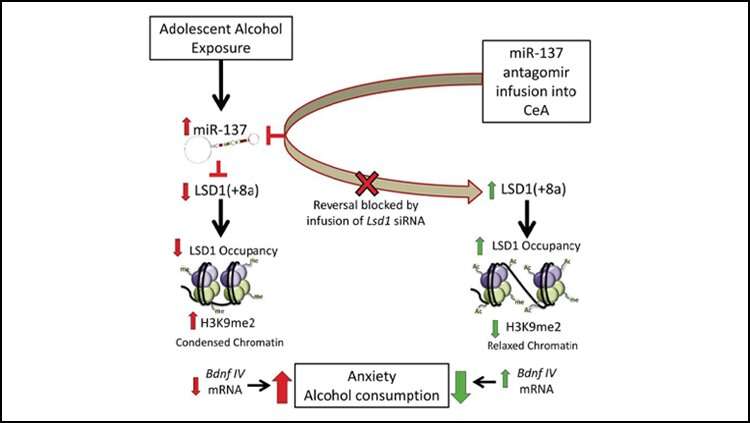Mechanism connects early binge drinking to adult behaviors

University of Illinois at Chicago researchers report that intermittent exposure to high levels of alcohol in adolescent animals leads to increased levels of microRNA-137—a molecule that regulates gene expression in cells—in the brains of adults.
Their findings, which are published in the journal eNeuro, also show that blocking microRNA-137 in adulthood helps to reverse or reduce the lasting effects of youth drinking in animal models, such as increased alcohol use and anxiety.
"MicroRNA-137 is an important part of normal brain development, but when young brains are exposed to high amounts of alcohol intermittently, as happens with binge drinking behavior, the molecule's regular function is altered," said Subhash Pandey, professor of psychiatry and director of the UIC Center for Alcohol Research in Epigenetics. "By altering microRNA-137 levels, binge drinking actually rewires the brain."
Pandey calls this alteration an epigenetic change, referring to changes in genes that are a result of environmental and social factors or exposures, not defects in the DNA's code.
In his study, Pandey and his colleagues mimicked adolescent binge drinking in young rodents by exposing them to alcohol in cycles: two days of alcohol exposure followed by two days without alcohol exposure. They repeated the cycle eight times. After the rodents grew into adulthood, their behavior and brains were analyzed. They were more likely than non-exposed rodents to choose alcohol over water when presented with options and they were more likely to exhibit signs of anxiety.
The altered levels of microRNA-137 also corresponded to altered levels of a target gene called LSD1.
This builds on prior research from the UIC Center for Alcohol Research in Epigenetics that suggests that epigenetic changes due to alcohol result from "limiting the brain's ability during the developmental years to form the connections it needs."
When the researchers blocked microRNA-137, LSD1 returned to levels comparable to rodents that were not exposed to alcohol during adolescence. Blocking microRNA-137 also led to reduced alcohol drinking and anxiety behaviors.
"Adolescent binge drinking is dangerous and has long-term epigenetic effects on the brain. Understanding this mechanism helps us get one step closer to understanding how those effects happen and how we can potentially undo that damage," said Pandey, who is also a senior research career scientist at Jesse Brown VA Medical Center.
More information: MicroRNA-137 Drives Epigenetic Reprogramming in the Adult Amygdala and Behavioral Changes After Adolescent Alcohol Exposure, eNeuro, DOI: 10.1523/ENEURO.0401-19.2019


















